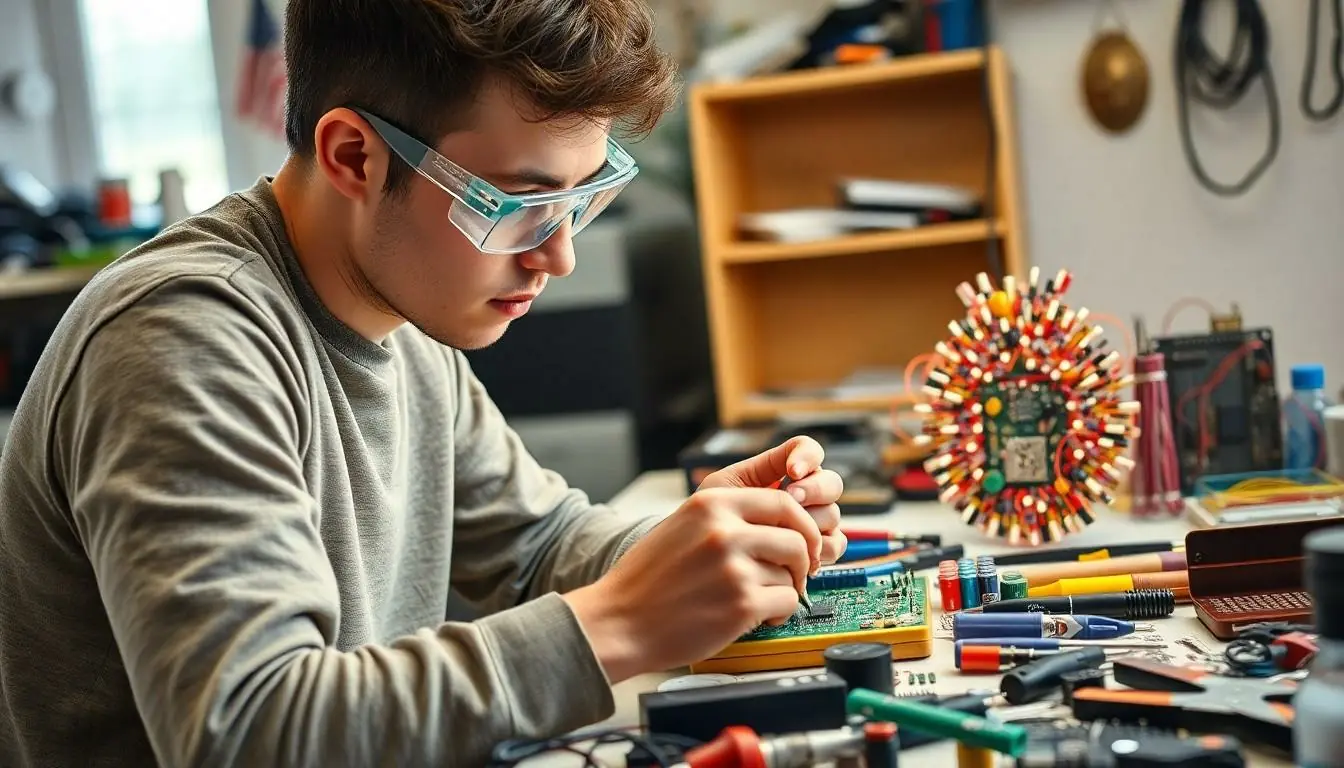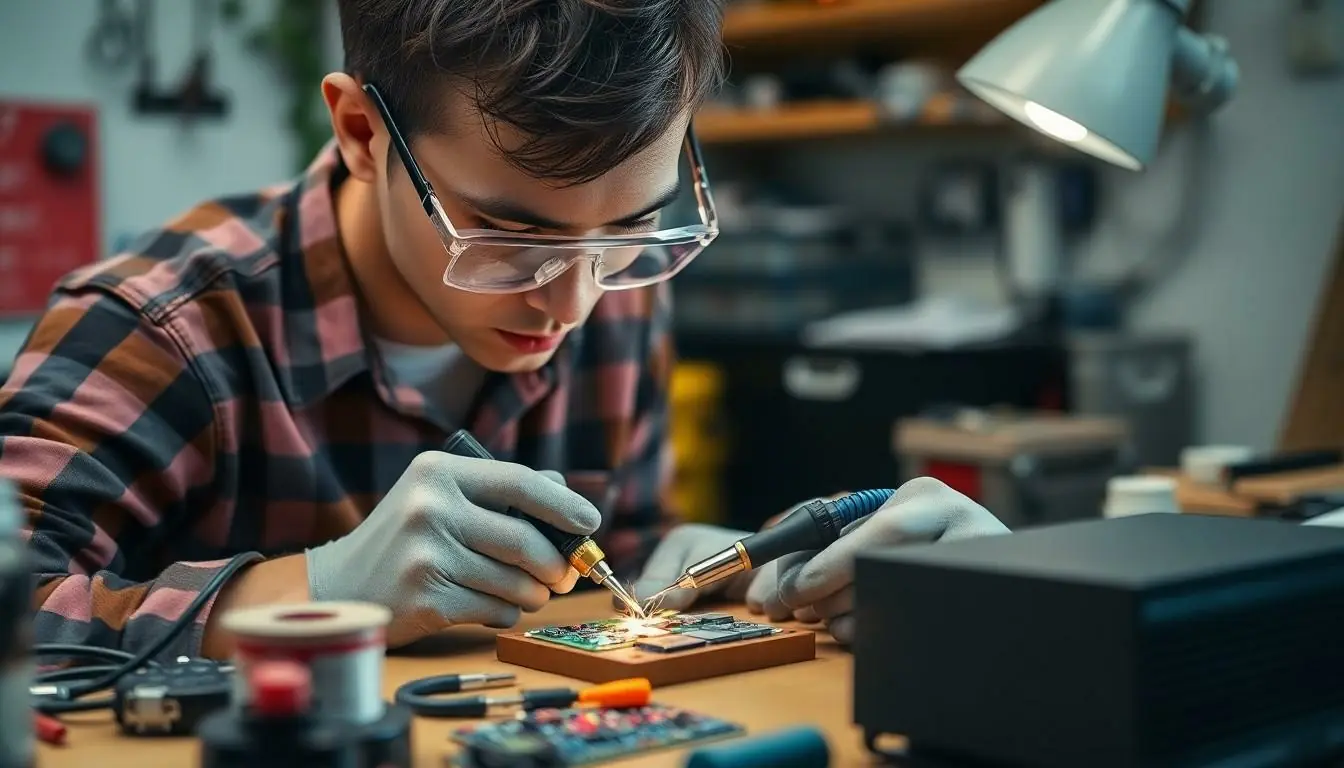Soldering might sound like a secret code for a superhero, but it’s actually the gateway to transforming ordinary electronics into extraordinary creations. Whether it’s fixing a broken gadget or crafting a unique piece of tech art, DIY soldering projects offer endless possibilities for makers of all skill levels. Who knew that a little melted metal could lead to such electrifying adventures?
Table of Contents
ToggleOverview of DIY Soldering Projects
DIY soldering projects encompass a broad range of activities that include both basic repairs and intricate creations. Beginners can start with simple items like repairing wires or creating basic circuits. Intermediate enthusiasts may explore assembling kits for gadgets, allowing them to practice while developing new skills.
Advanced soldering projects often involve unique designs, such as custom electronics or personalized tech art. Individuals enjoy crafting unique devices like vintage radio projects or LED displays, which showcase artistic vision alongside technical proficiency.
Learning soldering techniques opens doors to multiple opportunities, fostering creativity in electronics. Various resources, such as instructional videos and DIY kits, simplify the learning process. People can join community workshops or online forums to share insights, troubleshoot issues, and inspire each other.
Safety remains a top priority during any soldering project. Wearing protective goggles, using soldering irons responsibly, and ensuring good ventilation can help avoid accidents. Proper practices enhance the overall experience and lead to successful project completion.
Exploration of specific projects, such as building a simple amplifier or creating decorative lamps, highlights the diversity of options available. These projects provide not only practical skills but also satisfaction from seeing tangible results.
DIY soldering projects serve as a gateway to understanding electronics, motivating individuals to take on new challenges and expand their knowledge. Engaging in this hands-on activity often leads to a deeper appreciation for technology and fosters innovation in many areas.
Essential Tools for DIY Soldering
Having the right tools boosts the quality of any soldering project. Essential equipment makes the process smoother and more efficient.
Soldering Iron
A soldering iron stands as the cornerstone of DIY soldering. Selecting one with adjustable temperature settings allows for versatility across various projects. Consider using a fine-tipped iron for precision work, such as soldering small components. An ergonomic design enhances comfort during extended use. Popular wattage ranges are between 25 to 60 watts, suitable for most hobbyist applications. Brands like Weller, Hakko, and Tabiger offer reliable options favored by many enthusiasts.
Solder
Solder is critical for joining electronic components. Choose solder with a rosin core for better flow and conductivity. The standard diameter for solder is usually 0.56 mm to 1.0 mm, fitting various projects efficiently. Lead-free solder options are available, ideal for those seeking environmentally friendly solutions. Copper or silver solder enhances durability in high-quality connections. Always consider the melting point; standard solder melts around 183°C, enabling effective joining without damaging sensitive components.
Safety Equipment
Safety equipment ensures a secure soldering experience. Wearing safety goggles protects eyes from flux fumes and accidental splashes. Heat-resistant gloves are advisable to safeguard hands from burns. Using a fume extractor or working in a well-ventilated area reduces inhalation of harmful fumes. Keep a fire extinguisher nearby as a precautionary measure. Lastly, a first-aid kit is essential for addressing any minor injuries quickly.
Beginner-Friendly DIY Soldering Projects
Beginner-friendly soldering projects offer hands-on experience and practical applications. These projects serve as excellent starting points for honing soldering skills.
Simple LED Circuit
A simple LED circuit provides an ideal introduction to soldering basics. Connect a battery to an LED along with a resistor to limit current. Select a resistor based on the LED’s specifications, typically around 330 ohms for standard LEDs. Solder the components together on a small circuit board or perf board. This project allows experimentation with various LED colors and layouts, showcasing the effectiveness of soldering in creating functional electronics.
Homemade Soldering Iron Stand
A homemade soldering iron stand enhances safety and convenience during projects. Use materials like wood or metal to construct a stable base, ensuring it’s heavy enough to prevent tipping. Incorporate a metal holder to securely support the soldering iron while not in use. Adding a sponge can help keep the iron tip clean. This project not only provides a practical tool but also reinforces essential soldering techniques in a safe environment.
Intermediate DIY Soldering Projects
Intermediate projects offer exciting opportunities to deepen soldering skills and explore creativity. Here are two engaging project ideas.
DIY Electronics Kit
Building a DIY electronics kit enhances understanding of circuits and components. A variety of kits are available, targeting different interests and levels of complexity. Users can start with a basic kit that includes resistors, capacitors, and integrated circuits. This project reinforces essential soldering techniques while allowing for custom designs. Each component connects to a printed circuit board, creating a functional device once assembled. Engaging with such kits fosters problem-solving skills and encourages experimentation with circuit layouts.
Custom USB Charger
Creating a custom USB charger presents an excellent way to personalize tech accessories. Users can design chargers that match specific devices or aesthetic preferences. Gathering parts like a USB module, voltage regulators, and necessary connectors lays the groundwork for this project. By understanding the circuit requirements, individuals ensure compatibility with different devices. This hands-on experience reinforces electrical knowledge while improving soldering precision. Additionally, designing custom enclosures can add a creative flair to the final product.
Advanced DIY Soldering Projects
Advanced DIY soldering projects enable enthusiasts to push their skills further, diving into complex electronics. These projects often involve programming, custom designs, and innovative applications.
Arduino-Based Projects
Arduino-based projects offer extensive opportunities for creativity and technical learning. Using an Arduino microcontroller, she can create automated systems like home automation or robotic arms. Wiring sensors and components to the board allows for real-time interaction. He can build a weather station that collects data and displays it on an LCD screen. Numerous online resources provide guidance for both beginners and advanced users, making these projects accessible yet challenging. Engaging with Arduino’s vast community further enriches the experience through shared knowledge and inspiration.
Custom Circuit Boards
Custom circuit boards represent a significant step towards advanced soldering proficiency. Designing a bespoke circuit requires computer-aided design (CAD) software to create layouts. Once the design is ready, she can have the board fabricated by specialized services. Soldering components onto these boards not only enhances precision but also fosters a deeper understanding of electronics. Examples of projects include building a compact audio amplifier or creating a custom MIDI controller. By tackling these projects, he gains expertise in circuit design and electrical engineering principles, paving the way for more ambitious endeavors.
Conclusion
Embracing DIY soldering projects opens up a world of creativity and innovation. Whether someone is a beginner learning the ropes or an advanced maker tackling complex electronics, the satisfaction of creating something unique is unparalleled. With the right tools and safety measures in place, anyone can explore their potential and enhance their skills.
The journey through soldering not only leads to tangible results but also fosters a deeper appreciation for technology. Each project serves as a stepping stone, encouraging experimentation and problem-solving. As individuals dive into this rewarding hobby, they’ll find endless possibilities waiting to be discovered.




